When most people think about investments, their minds often jump to stocks, real estate, or tech startups. But for me, agriculture holds a special place. It’s an industry that’s as old as civilization itself, yet remains full of untapped potential and innovation. As someone who loves to travel, cook, and invest, I’ve come to appreciate agriculture not just for its financial returns, but for its ability to make a meaningful impact on the world.
Agricultural investments offer a unique blend of stability, growth, and the opportunity to support sustainable practices. Whether you’re looking to diversify your portfolio or make a difference, here are what I believe are the five best agricultural investments for profit.
1. Organic Farming Capitalizing on a Growing Trend
Organic farming has been one of the fastest-growing sectors in agriculture over the past decade, and for good reason. As consumers become more health-conscious and environmentally aware, the demand for organic products continues to rise. From fresh produce to organic dairy and meat, people are willing to pay a premium for food that is free from synthetic pesticides, fertilizers, and GMOs.
Investing in organic farming can be highly profitable, especially if you focus on crops that have a high demand but limited supply. Organic berries, avocados, nuts, and leafy greens are just a few examples. The key is to look for farms or cooperatives that are already established or are in regions known for their fertile soil and favorable growing conditions.
One of the benefits of investing in organic farming is the potential for strong long-term returns. As more countries adopt stricter regulations on food safety and environmental protection, the market for organic products is likely to expand even further. Additionally, organic farming often involves more sustainable practices, such as crop rotation and reduced chemical use, which can lower long-term costs and enhance soil health.
2. Agri-Tech Startups Riding the Wave of Innovation
Technology is revolutionizing agriculture in ways we never imagined, and investing in agri-tech startups is an exciting way to tap into this wave of innovation. From precision farming tools that use AI and satellite imagery to optimize crop yields, to vertical farming systems that allow crops to be grown in urban areas, the possibilities are endless.
Agri-tech startups are developing solutions to some of the biggest challenges in agriculture, such as water scarcity, soil degradation, and labor shortages. By investing in these startups, you not only have the potential to make substantial returns, but you’re also supporting innovative technologies that could transform the future of farming.
One area that particularly excites me is indoor vertical farming. These startups are creating highly controlled environments where crops can be grown year-round, using minimal water and space. This method is particularly promising for regions where traditional farming is challenging due to climate or land limitations. With urban populations continuing to grow, vertical farming is poised to play a significant role in feeding cities sustainably.
3. Timberland A Stable, Long-Term Investment
If you’re looking for a more traditional agricultural investment, timberland is worth considering. Investing in timberland offers a unique combination of stability and growth potential. Trees are a renewable resource that grow in value over time, and timberland investments tend to be less volatile than stocks or other types of real estate.
Timber is used in a wide range of industries, from construction to paper and packaging. Demand for timber is likely to remain strong, especially as global populations grow and urbanization continues. What’s more, timberland investments can provide a hedge against inflation. When inflation rises, the price of timber often goes up as well, providing a natural buffer for investors.
Beyond its financial benefits, timberland can also be managed sustainably, making it an attractive option for environmentally conscious investors. Many timberland investments include programs for reforestation, wildlife conservation, and carbon sequestration, allowing you to align your financial goals with your values.

4. Regenerative Agriculture Investing in Soil Health and Sustainability
Regenerative agriculture is an approach that goes beyond organic farming to focus on rebuilding soil health, enhancing biodiversity, and sequestering carbon. This method uses practices like cover cropping, no-till farming, and holistic grazing management to improve soil quality and increase the resilience of farms against climate change.
Investing in regenerative agriculture is not just a good deed; it’s a smart financial move. Healthier soil leads to more productive farms, which can produce higher yields and reduce the need for expensive inputs like synthetic fertilizers. Moreover, as consumers and businesses become more aware of the need for sustainable food production, there is a growing market for products that are certified as regeneratively farmed.
Some of the best opportunities in regenerative agriculture include investing in farms transitioning to these practices or in companies that provide the technology and expertise needed to support this shift. As governments and private sectors increasingly recognize the importance of sustainable agriculture, there are likely to be more incentives, subsidies, and support for regenerative farming, creating additional opportunities for profit.
5. Aquaculture The Future of Sustainable Seafood
As global demand for seafood continues to rise, the pressure on wild fish stocks has become a critical concern. This is where aquaculture—also known as fish farming—comes into play. Aquaculture involves the controlled cultivation of aquatic organisms such as fish, shellfish, and seaweed, and it’s one of the fastest-growing sectors in the food industry.
Investing in aquaculture offers several advantages. First, it provides a scalable and sustainable way to meet the rising demand for seafood without further depleting wild fish populations. Second, advancements in technology are making aquaculture more efficient and less environmentally impactful. From recirculating aquaculture systems (RAS) that minimize water use to innovative feed solutions that reduce reliance on wild-caught fish, there are many ways to optimize this form of farming.
Aquaculture isn’t just limited to fish; there’s also a growing market for shellfish and seaweed farming. Seaweed, in particular, is gaining popularity for its nutritional benefits and versatility. It’s used in everything from food products to cosmetics and biofuels, and it even has potential as a carbon sequestration tool. Investing in diversified aquaculture operations or companies that support sustainable practices can yield substantial returns while contributing to a more sustainable food system.
Conclusion A World of Opportunity in Agriculture
Agricultural investments offer a unique combination of profit potential and positive impact. Whether you’re drawn to organic farming, agri-tech startups, timberland, regenerative agriculture, or aquaculture, there are many ways to invest in the future of food. These investments not only provide opportunities for financial growth but also allow you to contribute to sustainable practices that can help nourish the world and protect the planet.
As an entrepreneur, I’m excited about the possibilities these agricultural sectors hold. They align with my values and passions, and they offer the kind of growth potential that’s hard to find elsewhere. So, if you’re looking to diversify your portfolio and make a difference, consider exploring the world of agricultural investments—you might just find it’s the best decision you ever make.
Cheers to growth, sustainability, and smart investments!
Until next time,
Harvey Manzel
Manzel

Leave a Reply